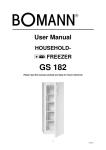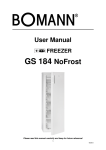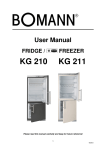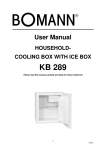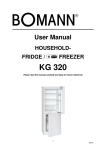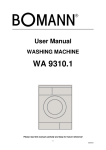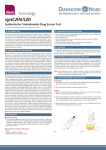Download GS 199_GB
Transcript
User Manual HOUSEHOLDFREEZER GS 199 Please read this manual carefully and keep for future reference! 1 01/2012 TABLE OF CONTENT OVERVIEW DISPOSAL OF USED DEVICES IMPORTANT USE AND SAFETY INSTRUCTIONS General safety precautions Risk of injury Coolant Intended use Unpacking PRODUT DESCRIPTION Delivery scope Specifications INSTALLATION Location Electrical connection REVERSE THE DOOR OPENING STARTUP / OPERATION Prior to first use Turning on Storing food Defrosting Operating noise Turning off TIPS FOR SAVING ENERGY MAINTENANCE AND CLEANING Cleaning and care Repairs What if . . . Troubleshooting 2 2 3 3 3 3 3 3 4 4 4 5 5 5 5 6 6 6 7 7 8 8 8 8 8 9 9 OVERVIEW Please read this user manual thoroughly before first time operation. It includes important information with regard to installation, operation and maintenance of the device. Improper use may cause hazardous situations, especially for children. Keep this manual for future reference. Pass it on to any future owner of this product. In case of any doubt regarding questions or topics which are not extensively described in this manual, please contact your distributor or a technician. DISPOSAL OF USED DEVICES This product is marked in accordance with the European waste regulation 2002 / 96 / EC - WEEE It regulates the proper disposal of the product. Environmentally friendly disposal will prevent possible negative consequences to health caused by improper disposal. This symbol on the product or its packaging indicates that this product must not be disposed of with the regular household waste. The user has to return the product to a collection point for the recycling of electric and electronic equipment. The disposal must comply with the local regulations in place. For further information please contact your local authorities or waste collection service. Disable waste equipment before disposal: • Disconnect the mains plug from the wall socket. • Disconnect the plug from the mains cable. • Remove or disable any existing spring or latch locks. This will prevent children from locking themselves (risk of suffocation!) or from getting into perilous situations. Children might not understand the risks that arise from handling household devices. Therefore, observe children and make sure they do not play with the device. 2 01/2012 IMPORTANT USE AND SAFETY INSTRUCTIONS General safety precautions All safety information in this user manual are marked with a warning symbol. They indicate possible dangers precociously. It is imperative to read and follow these information. • Do not touch the plug at the mains cable with wet or moist hands when connecting or disconnecting. Risk of death by electric shock! • In case of emergency, unplug the device immediately. • Hold the plug when disconnecting the mains cable; do not pull the cable. • Disconnect the plug before cleaning or servicing. • Regularly check the device and cable for signs of damage. Do not continue to operate the device in case of damage. • A damaged mains cable must be replaced by the manufacturer or a technician and without any delay. Do not use the device with a damaged cable or plug. • Do not repair the device by yourself. Please contact authorized personnel. In order to avoid hazards. A damaged mains cable must be replaced with an equivalent cable by the manufacturer or qualified specialist. • Except for cleaning and maintenance work described in this manual, no other alterations of this device must be executed. • Do not place vases or other containers filled with liquids on the device. Risk of injury! • So that you can disconnect the appliance quickly in event of an emergency, do not use extension cables. • This device may not be operated by children or persons with physical, sensory or mental abilities or lack of experience and knowledge, unless they are supervised or guided. • Children should be supervised to ensure that they do not play with the device. • Transport the unit never with content. WARNUNG • Packaging materials (e.g. plastic bags, polystyrene) are dangerous for children. Risk of suffocation! Keep packaging materials out of reach of children. • Containers with flammable gases or liquids can leak due to cold ambient temperatures. Risk of explosion! Do not store combustible materials such as aerosol cans or refill cartridges for lighters in your device. Coolant CAUTION The coolant circuit of this device contains the refrigerant Isobutane (R600a), a natural gas that is flammable and of high environmental compatibility. Make sure no parts of the Coolant circuit gets damaged during transport and installation of the device. If the coolant circuit is damaged: • it is imperative to avoid any open flames or ignition source. • thoroughly air the room in which the device is installed. Intended use • This device is intended for private use. It is suitable for freezing food. • The manufacturer is not reliable for any damage resulting from improper or other then intended use. • For safety reasons, alterations or modifications of the device are prohibited. • Please keep in mind that the manufacturer is not reliable for any damage resulting from commercial or any other use then freezing food. Unpacking The packaging must be undamaged. Check the device for any possible transport damage. Do not install a damaged device. In case of damage, please contact your distributor. 3 01/2012 ATTENTION Remove the separate polystyrene part (transport protection) between the rear of the device and condenser – metal grid (if available). Packaging material The packaging for transportation of the device and individual parts is produced of recyclable materials. • corrugated cardboard / paperboard (mainly of waste paper) • form part of PS (foamed, CFC-free polystyrene) • Films and bags of PE (polyethylene) • Strapping strips of PP (polypropylene) IMPORTANT Make sure you dispose of packaging materials environmentally friendly. Removing the transport protection The device and parts of the interior are protected for transport. Remove all adhesive tapes from the right and left side of the door. You may remove adhesive residue with a cleaning solvent. Also remove any adhesive tapes and packaging materials from the inside of the device. PRODUCT DESCRIPTION Delivery scope 4 Freezing drawers, ice-cube tray, user manual (D, GB) Specifications BOMANN Model No. Energy efficiency class(1) Climate class(2) Gross/net capacity, total Freezing capacity Storage time by power failure Energy consumption(3) Connection voltage Connection power Operating noise Sizes H x W x D Gross / net weight Coolant GS 199 A++ N-T 88/80 litre 6 kg/24h 12 h 0.385 kWh/24h - 140 kWh/year 220-240 V, 50 Hz 70 W 43 dB(A) 84.5 x 54.5 x 57.0 cm 39.5 / 37.0 kg R600a (1) A+++ (highest Efficiency) up to G (lowest Efficiency) Climate class SN (Subnormal): ambient temperature of +10°C up to +32 C Climate class N (Normal): ambient temperature of +16 C up to +32 C Climate class ST (Subtropics): ambient temperature of +16 C up to +38 C Climate class T (Tropics): ambient temperature of +16 C up to +43 C (3) The actual energy consumption depends on the use and installation of the device. (2) All device-specific data of the energy label have been determined by the manufacturer under laboratory conditions in accordance with pan-European standardized measuring methods. These are regulated 4 01/2012 by ISO EN 15502. The actual energy consumption depends on the usage and might therefore also be above the values determined by the manufacturer under standard conditions. An expert knows these relations and will execute the tests with special measurement instruments in accordance with the regulations in place. MANUFACTURER DATA Product is subject to changes and improvements. INSTALLATION Location Sufficient ventilation around the device is necessary in order for the heat to dissipate properly and to guarantee efficient cooling operation at low power consumption. For this purpose, leave sufficient space around the device. • Minimum clearance of 7,5 cm between rear side and wall, • at least 10 cm on both sides and 10 cm on top of the device. • Leave proper space in front of the device in order to open the door at an angle of 160°. • • • • • • • • IMPORTANT Do not expose the device to direct sunlight. Do not place near heaters, next to a stove or any other heat sources. Do not use the device outdoors. Only install at a location with an ambient temperature suitable for the climate class of the device. For information on the climate class, please refer to chapter “Specifications“ or to the rating label located in the interior or on the rear side of the device. Avoid installation at locations with high humidity (e.g. outdoors, bathroom), as metal parts would be susceptible to corrosion under such circumstances. Do not place the device near volatile or combustible materials (e.g. gas, fuel, alcohol, paint, etc.) and in rooms which may have poor air circulation (e.g. garages). Only place on a steady and safe surface. If the device is not horizontally leveled, adjust the feet accordingly. Electrical connection The kind of current (AC) and the voltage must be conform with the data of the rating label, located inside or outside on the back of the unit. In case of heavy voltage fluctuations, it is recommended to use an automatic alternating current regulator. The plug, together with the grounding conductor, must fit into the wall socket. The mains plug must be freely accessible. Mains cable • Do not extend or roll up the cable during operation. • Also, the cable must not be near the compressor on the rear side, since latter one gets hot during operation. In case of any contact, the isolation would be damaged resulting in electric leakage. • The use of extension cables is not recommended. • Do not connect the device to the mains with wet hands. • Install the device for the wall socket to be freely accessible. REVERSE THE DOOR OPENING If required, the door opening can be moved from the right (supplied condition) to the left side. WARNING When replacing the door stop, the device must be disconnected from the power supply. Always unplug the device first. 1. Use a flat bladed screw driver to remove the screw covers at the device top cover. Unscrew the below screws and remove the device cover. 2. Tilt the device slightly backwards and block it in this position. 3. Loose the screws of the upper door hinge and remove the hinge along with the hinge pin. 5 01/2012 4. Open the door a little, take it carefully of the lower door hinge and place it on a padded surface to prevent it from scratches. 5. Turn the separate foot off and remove it and the lower hinge along with the foot and hinge pin by unscrewing the screws. Unscrew the pin and put it at the opposite of the hinge. 6. Now screw the hinge incl. foot and the separate foot at the opposites of the device. 7. Put the door on the lower pin of the hinge and fix the door to the property position. 8. Mount the upper door hinge with the screws at the device opposite, upon you unscrewed the hinge pin and put it in at the other side of the hinge again. 9. Afterwards the device top cover is to fix on again. Check if the door is arranged vertical as well as horizontal, so that a smooth opening and closing of the door is ensured. STARTUP / OPERATION Prior to first use ATTENTION After transport, the device should be left standing for 4 hours in order for the oil to be collected in the compressor. Nonobservance could cause damage to the compressor and hence result in failure of the device. This would void your warranty claim. • Clean the interior of the device including all accessory parts located inside. Connect the device to the mains supply IMPORTANT • The device must be earthed properly. For this purpose the plug of the mains cable has been fitted with the intended lead. • Contact an electrician if the plug does not fit in the wall socket. • In case you disconnect the device or in case of power failure: Wait for 5 minutes before restarting the device. Turning on Turn on the device by connecting the plug to a wall socket and turning the temperature control, which is located at the device front. Please also refer to chapter “Settings“. Settings Setting • – OFF indicates the device is turned off. Turn the temperature control clockwise, starting from this setting; the device will turn on automatically. The Settings MIN – MAX regulate the inside temperature. Setting • Setting MIN Setting MAX = = = OFF lowest setting (warmest inside temperature) highest setting (coldest inside temperature) Turning the temperature control clockwise will lower the inside temperature. Please keep in mind that the temperature changes with the ambient temperature (of the location), with the frequency of opening the door and the amount of food in the device. During initial operation, turn the temperature control to the highest setting first, until the device has reached the desired operating temperature. Afterwards It is recommended to turn the control back to a medium setting, correcting the temperature at a later point would then be easier. 6 01/2012 Storing food The freezer allows you to store frozen food at a temperature of -18°C or below (from a middle temperature control setting) for several months, to produce ice cubes and to freeze fresh good. The temperature of the device is automatically controlled by the temperature control. Due to external influences such as room temperature, placements, frequency of opening the door and the amount of food the temperature in the freezer can be influenced. Freezing • 24 hours before freezing we recommend to turn the temperature control to the max. setting and to keep this setting even after freezing for a few hours. The device is not compromised if the setting will not revert to a normal operating temperature (temperature control in middle setting) after the freezing process, but for economic reasons you should possibly avoid it. • Place fresh food to be frozen in the upper compartment. In order for that to be always possible, frozen food items need to be rearranged frequently. • Fresh food should be frozen as fast as possible to the core. Therefore during freezing operation, the temperature of fresh food should be lowered as fast as possible in order to keep formation of ice crystals as little as possible and not to damage the food structure. • If the freezing process is too slow, ice crystals build up and the food quality might get affected. • Even frozen food should be stored in the lower compartments, in order to keep the upper compartment available for fresh food. • Frozen food should be kept in contact with the bottom of the compartment. • Keep a space between the single items for air circulation. Storing frozen food • Packed frozen merchandise should be stored in a 4-star-freezer compartment in accordance with the manufacturer’s data. Make sure the food items do not defrost after purchase and to store them as fast as possible in the freezer. • It is possible to store food for longer periods of time, up to three months. This period might vary, so please observe the storage information on the packaging of the merchandise. IMPORTANT Make sure that the temperature in the freezer does not rise above -18°C. Moreover the device should be defrosted regularly. A thick layer of ice on the wall deteriorates the cooling effect and the power consumption increases. Safety precautions • Do not store sizzling drinks in this device, such as mineral water, beer, sparkling wine, coke etc. (risk of explosion). • Once products have been defrosted halfway or completely, they should be consumed as soon as possible and should not be frozen again, except they have been processed to a ready meal. • In case of power failure, do not open the door. If the failure does not take longer than 12 hours, the food will not be affected. • Do not store bottles or cans. These can break when the contents freeze – or even explode, if they contain carbonated drinks. • Do not eat food that is still frozen. Do not allow children to eat ice cream directly from the freezer. The cold can cause injuries in the oral cavity. • Touching metal parts inside the device can cause symptoms similar to burns if the skin is very sensitive. • Do not touch frozen food with moist or wet hands; they could freeze to the items. • For safety reasons, the freezer compartments feature a stopper. But they can also be removed completely by pulling them upwards and then removing them. Reattach in reverse order. Defrosting To achieve better cooling and to save energy, defrost the device regularly. To start the defrosting process turn the temperature control to the position • - OFF and disconnect the plug. Remove the food items as well as the compartments and keep covered at a cool location. When the ice has melted, pour the condensate away and dry the interior of the device. You may then restart the device by connecting the plug and turning the temperature control. 7 01/2012 WARNING Never use metal objects (e.g. knives) for removing ice from the vaporizer. The vaporizer could be damaged. A defect vaporizer could cause serious damages. Operating noise TYPE OF SOUND Mumbling NORMAL NOISE Liquid sounds Click sounds Disturbing noises CAUSE/ SOLUTION Caused by the compressor during its operation. This is stronger when it turns on or off. Caused by the circulation of the refrigerant in the device. The temperature control turns the compressor on or off. Vibration of the shelves or cooling coils – check if those are securely fastened. Turning off Turn the temperature to setting • – OFF in order to turn off the device. If the device will not be operated for a longer period of time: • Remove the entire food from the device. • Turn the temperature control to setting • - OFF. • Disconnect the plug or turn off / unscrew the fuse. • Thoroughly clean the device (refer to chapter of “Cleaning and Care”). • Keep the door open in order to prevent bad odors. TIPS FOR ENERGY SAVING • Disconnect the plug if you do not use the device. • Do not install the device near stoves, heaters or other heat sources. In case of higher ambient temperatures, the compressor will run more frequently and longer. • Ensure sufficient ventilation at the bottom and rear side of the device. Never block any ventilation openings. • Allow warm dishes to cool down before putting them in the device. • Do not open the door longer then necessary. • Avoid opening all freezer compartments at the same time. • Make sure that the temperature in the freezer does not rise above -18°C. • The device should be defrosted regularly. • Always keep the condenser – metal grid on the rear side (if existing) – clean. • Make sure the door sealing is in good order for the door to close properly. MAINTENANCE AND CLEANING Cleaning and care For hygienic reasons, clean the interior and accessory parts regularly. WARNING • Always disconnect the plug or turn off/ unscrew the fuse before cleaning. Pull the plug and not the cable. • Do not use steam cleaners for cleaning the device; moisture could enter electrical components. Risk of electric shock! Hot steam could damage the plastic parts. The device must be dry before restarting operation. • Essential oils and organic solvents, such as the juice of lemon or orange skin, butanoic acid or cleaning agents containing acetic acid can damage plastic parts. Prevent contact of any part with such substances. Do not use abrasive cleaning agents. Pls. do as follows: • Remove all food and keep covered at a cool location. • Use warm water and a mild detergent for cleaning the interior (including rear side and bottom). 8 01/2012 • After thorough drying, restart operation. • Clean the condenser - metal grid on the rear side (if existing) once a year, using a soft brush or vacuum cleaner. WARNING Do not bend the cooling coils. Do not use arenaceous abrasives. Repairs WARNING Servicing of electric devices must be conducted by qualified experts only. Incorrect or improper repairs constitute a risk for the user and will void the warranty! What if . . . Troubleshooting The design of the device ensures a trouble-free operation as well as a long life cycle. Nevertheless, if any defect occurs during operation, please check if it is caused by improper operation. The following problems can be solved by you by checking for the possible cause. PROBLEM The device is not cooling properly or at all POSSIBLE CAUSE Is the plug securely connected to the mains? Has the safety mechanism of the wall socket been triggered? Is the temperature control properly set? Is the place unqualified? Do food items or shelves and/or drawers prevent the door from closing properly? Is the ventilation of the device hedged? SOLUTION Connect the plug properly to the socket, turn on the fuse, and contact a technician if necessary. Check the settings. Check the ambient temperature. Arrange the food or shelves and/or drawers properly. Clear the ventilation slits, install the device freely Loud noise Does the device not stand vertical or hori- Adjust the feet accordingly. during opera- zontal? Liquid flow sounds in the cooling circuit are tion normal. Water on the Is the temperature control set properly? Check the temperature settings. bottom Note. On days of high humidity, condensation might occur on the outer surface of the device. This is no malfunction; you may simply wipe the water off. If a problem still persists after following the steps above, please contact your distributor or a technician. Are you interested in other Bomann products? Please visit our website: www.bomann.de Distribution: C. Bomann GmbH • Heinrich-Horten-Str. 17 • D-47906 Kempen 9 01/2012









